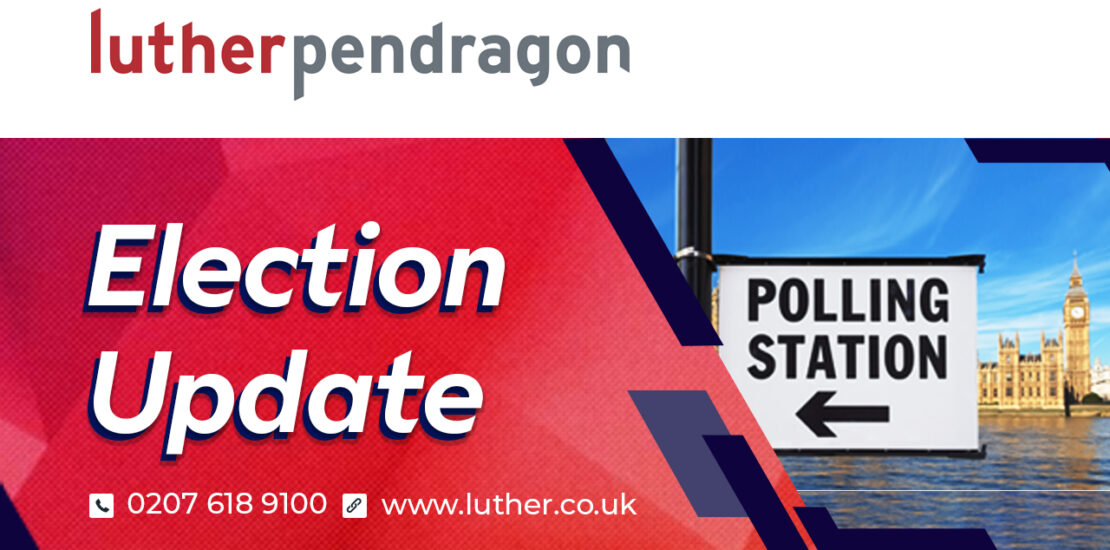- June 20, 2024
- Posted by: lutherpendragon
- Categories: insight, news

Weekly election update – week 2
This week saw the parties release their manifestos. While they contain interesting and positive ideas for incremental reform in different sectors, they don’t seem to – at least from the major parties – present a major transformational change.
They leave open serious questions about future levels of public spending and the tax burden going forward, which both leaders are notably silent on.
Our update therefore considers what the future may hold and where this much-needed clarity might come from. Large areas of policy are up for grabs to be shaped post-election – but where will the influence and power lie in the decisions about what comes next?
The manifestos leave a lot of leeway for officials in key government departments like the Treasury – Labour wants to give more fiscal planning powers to the Enterprise and Growth Unit for example – to interpret these documents and consequently plan for the likely change in government in the next few weeks.

Adam Thomas
Director and Head of Public Affairs
Big tradeoffs on public spending await, but the manifestos are silent on the answers
The Labour and Conservative manifestos remain stubbornly silent when it comes to the big decisions that need to be made on future public spending and tax.
This has major implications, as the OBR forecasts that the next Budget will be based on will use the assumptions left by the current government. While it’s unlikely that the current government’s proposed spending envelope will turn out to be what is delivered, we’re all in the dark about what the outcome will actually be, with only months to go before existing spending plans run out.
Labour’s costings document only covers the year 2028/29 with no information on the intervening years. Given the tight timescales, it’s likely that if Labour wins it will split the Spending Review process, holding an initial one-year review to set 2025/26 settlements, then taking their time to decide spending when interest rates have likely fallen and growth has picked up, across the rest of the parliament.
Plus, Rachel Reeves has discussed changing the remit of the OBR to focus on the long-term impact of capital spending on growth, which if implemented, would significantly change the modelling assumptions.
Labour will face strong pressure to get its agenda off to the best possible start. Will these changes give it the headroom it so desperately needs?
What does the Lib Dem manifesto tell us about the role of the party in next parliament?
The Liberal Democrats are expected to make gains at the expense of the Conservatives, which will likely see them become the third largest party in Parliament. This will open new mechanisms to influence the political agenda, such as Lib Dem MPs gaining Select Committee Chair positions and the Leader asking weekly back-to-back questions at Prime Ministers’ Questions.
That’s why it’s worth considering what the Lib Dem manifesto may tell us about how their enhanced status could affect the next Parliament. Their headline revenue raiser – doubling Capital Gains Tax for top earners – may provide Labour cover to do similarly, not just on capital gains, but other taxes on wealthy individuals and businesses. It’s also important to remember that the Lib Dems were the first to call for a windfall tax on oil and gas companies and, of course, political parties are certainly not averse to stealing policies from each other.
How will Labour’s preventative agenda be delivered in government?
Labour’s announcements this week have placed a strong emphasis on preventative policies. Everyone agrees that it’s better to tackle problems early before they become bigger – and more expensive – to deal with. But is Whitehall really set up to deliver on this?
Take health policy – where the party has said that prevention is “always better, and cheaper, than a cure”, announcing action on childhood obesity and greater investment in diagnostic equipment. But what they haven’t said is how they would find the money to make it happen. The NHS already takes c. 40% of public spending and just a 1% increase in spending means finding huge savings from other departments, causing major headaches in other parts of the system.
Prevention requires a joined-up approach, not just between central government departments, but also local government – where spending on early intervention has fallen by nearly 50% – and other specialist public bodies and regulators. Commitments on local government finance in the manifestos look to be pretty broadbrush to say the least. Traditionally, the Treasury has been reluctant to recognise preventative spending because it requires it to release significant upfront investment when it is difficult to calculate the outcomes and savings it is expected to deliver, often many years into the future.
But given the importance Labour has placed on this, it feels like there is now a real opportunity to change the debate on this issue, with a new set of politicians ready and willing to help make the case.
Can we just double check this
Following the Euro elections, who will Keir Starmer be negotiating with?
Despite much of the coverage focusing on a far-right ‘surge’ in the recent European Parliament Elections, the pro-European centre has held firm, with the EPP and S&D groupings remaining the two largest parties. EU Commission President Ursula Von der Leyen is also on course for a second term, although her path to securing the 361 votes required for a majority is narrow.
Whilst far-right parties will hold almost a quarter of the seats in the new Parliament, their performance was mixed outside of the bloc’s major economies, and they do not have a history of collaborating within one unified group, which will limit their ultimate influence. Nevertheless, the repercussions of the vote for national governments have already been felt, most notably with French President Macron calling snap parliamentary elections, potentially confining himself to an awkward “co-habitation” arrangement with Le Pen’s National Rally until 2027. While Olaf Scholz finds his coalition weakened by the performance of far-right Alternative für Deutschland (AfD).
That also has implications for Labour should they win. The Labour manifesto commits the party to not rejoining the Single Market or Customs Union, and instead anticipates a more painstaking renegotiation of the existing Trade and Cooperation Agreement (TCA) which is due in May 2026 and will need careful planning and preparation throughout 2025. With the EU unlikely to go beyond the bureaucratic high-level technical checks mandated by Article 776 of the agreement, any initiative to re-negotiate will have to come from Labour and that will require forging alliances and partnerships across Europe’s political divides.
The Scottish debate – what influence will Scottish Labour have in a Starmer government?
This week the Scottish party leaders clashed again in the BBC debate, seeing John Swinney tackle Anas Sarwar over Labour’s public spending proposals, accusing Labour of being part of a “conspiracy of silence” on an impending “£18 billion of cuts”. While we still expect Scottish Labour to make significant seat gains, the latest poll is showing that the SNP and Labour are neck and neck, and tantalisingly for the parties, over 40% of Scottish voters are saying they may change their minds before polling day.
The stakes are high running up to the Scottish election in 2026. For Scottish Labour, there will be many advantages to working closely with a Labour government in Westminster, not least with GB Energy being HQ’d north of the border. Also, for the first time in 14 years Scottish Labour will have a voice in Westminster politics, with places at the Cabinet table and in junior ministerial positions.
But there’s a difficult balance to strike. Anas Sarwar needs a smooth glide path to the 2026 Scottish elections. The Scottish party will expect a payback for making a significant contribution to a Labour majority, giving a Scottish Labour caucus heightened expectations about what Starmer will do for Scotland in return – and a heightened influence on where investment and any cuts will fall. Sarwar cannot risk allowing the SNP ahead of 2026, to position itself as the ‘change’ party against a UK Labour government. The continuing dynamic between the two will be interesting one to follow post-election.
How behavioural science explains the risk tolerance for Sunak and Starmer
In the week where manifestos were unveiled, it’s useful to consider the framing and positioning of the main parties. One of the primary theories underpinning behavioural science, prospect theory, may help explain why Rishi Sunak and his team appeared to be throwing the kitchen sink at the document, while Keir Starmer arguably chose a more cautious approach. The theory holds that when people regard themselves in the domain of gains they tend to be risk averse. On the flipside, when people regard themselves in the domain of losses, they tend to be risk seeking. With a commanding lead in the polls, the Labour Party is naturally more guarded while the Conservative Party is taking more risks to try and claw back support.
Where to find all the manifestos released this week:
|
How can we help you?
Luther Pendragon is one of the UK’s most highly-regarded independent communications consultancies. We help clients reach, inform and engage with policymakers and stakeholders in Government, Parliament, the devolved administrations, regulators, and beyond.
If your organisation is looking to shape the political and policymaking landscape after the General Election, we can support you.
Contact us at publicaffairs@luther.co.uk to find out more about how we can help.
